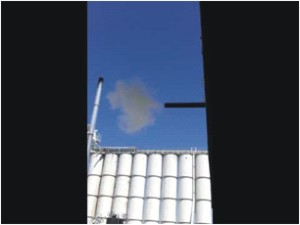
Hitting natural gas savings goals has a perceived difficulty, likely because there are fewer technologies that save natural gas compared to those that save electricity. A major widget, the condensing gas furnace, will be required by federal fiat starting next heating season. The baseline for this technology moves up, squeezing out the vast majority of savings. Compounding gas-program goal attainment is abundant low-cost shale gas from hydraulic fracturing. This has driven prices to historic lows, reducing dollar savings which negatively impact cost effectiveness for decision makers.
Do not despair. There are many gas-saving measures for retrofit and new construction that are still highly cost effective with large savings potential and low penetration rates.
Flash Steam Recovery
Pressure cookers are used to generate water temperatures higher than the atmospheric boiling point of 212F by sealing the vessel to mitigate boiling, which increases both pressure and temperature. If the relief valve is opened, water inside will boil off until it is cooled to 212F again. The same thing occurs in many condensate (hot water) return systems, particularly in manufacturing plants. High pressure condensate “flashes” off steam when it is relieved to the atmospheric pressure of the return system back to the boiler. The result is lost condensate temperature and lost water vapor that must be made up from the cold tap. Flash steam can be identified as shown in the photo nearby. Any sign of steam [1] loss is an opportunity, and the savings potential may be huge.
Insulation
Yes, there are many opportunities for slam dunk projects by insulating valves, fittings, strainers, and pumps. Virtually everything [2] in a steam or hot water system that is hot can be insulated with impressive ROI.
Swimming Pool Covers
This is another boring technology with tremendous energy saving potential, particularly when pools are not in use much of the time (schools). Nearly the entire heating load for a swimming pool is evaporation. Cover the pool; stop evaporation; do the math.
Heat Recovery
There is always potential for savings when warm or hot air / exhaust, water, or other fluids are released to the surroundings. It is almost always best to return recovered heat to the system it comes from for the simple reason that the heat is available when the system can use it. It is almost never cost effective to recover heat from a process for space heating because the hours are few, and the demand for heat is low. The higher the temperature, the greater the opportunity.
Heat Recovery Chillers
This is a relatively new, and therefore, underutilized concept. All major water chiller manufacturers offer heat recovery chillers that can produce hot water up to 160F. Food processing, hospitals, and other facilities with humidity control requirements can be great applications for these.
Taking the incremental equipment efficiency path to natural gas savings goals is a long, winding, and slippery slog. Consider systemic heat losses and how to reduce those to cruise to victory.




